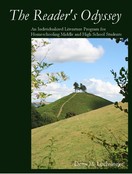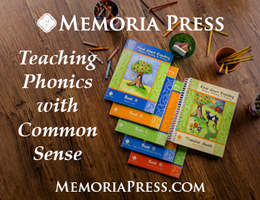The Reader’s Odyssey: An Individualized Literature Program for Homeschooling Middle and High School Students grew out of author Dena Luchsinger’s experience teaching her own children as well as from working with other parents. Since students are individuals with their own tastes and interests, she decided that it made sense to capitalize on student preferences to develop an appreciation of good literature rather than to impose our own or someone else’s preferences. The role of parents then is to make the books available, outline the basic requirements to be met, and implement methods of accountability. Those methods might well include discussion about the book with the parent, so parents might also be investing time reading the books with their children.
The Reader’s Odyssey seems to emphasize the high school level since it has two pages where it outlines a four-year literature course in general terms. However, it can easily be implemented with students in junior high as well by following the suggestions for freshman and sophomore years.
Parents begin by creating a library of appropriate books from which their children can select those they wish to read. This might be the most daunting part of the program. Luchsinger strongly encourages that books be immediately accessible in your home library so that students can “try them out.” Books might be digital or print, and students might also listen to audio books while reading along in a print or digital version. Luchsinger suggests, “A reasonable size for any initial collection is approximately whatever number of books your student might normally read in a school year times ten” (p. 30). So for a student who reads ten books in a year that would be 100 books. While I love this idea, I think that if you have a library close by that students can visit frequently, you might be able to work with a smaller collection. And don’t forget that digital versions of many classics are readily available online for free. The collection should include a mix of classics and contemporary fiction, contemporary non-fiction, books from a variety of genres, and books on topics of interest to your child. Lists of books the author recommends are included as a starting point rather than as a prescriptive list.
Parents create a checklist or work with the student to create a learning contract that sets out course requirements regarding the type of literary works to be used, the learning process(es) to be used (i.e., guidelines for use of audio books or DVD versions), and “learning products” such as reading logs, worksheets, book reviews, essays, and discussions.
A checklist for a school year might, for example, require a student to read two works of classic fiction, two works of modern fiction, four fictional works that represent different genres, two different types of non-fiction, and two short works. Students might maintain a reading log, write a summary of each work, write a book review of their favorite work, and use one or more of the worksheets provided in the appendix. Students might be allowed to use one literary work to fill two requirements. For example a work of fiction also represents a particular genre. A parent might set a minimal number of total literary works to be read.
Students select from among the collection (or from a parent-approved list) of good and great books those that are most interesting to them. Students might begin one book, but decide they are not interested and pick up a different one.
Students start with more breadth and variety the first few years as they explore various genres and become familiar with the styles of different authors. By senior year, they should be narrowing down to fewer, more-challenging books with which they interact at a deeper level, perhaps writing literary analyses or a research paper.
The first half of The Reader’s Odyssey explains how to create this type of literature program. The second half includes annotated book lists by genres, a list of recommended authors, and a list of “Classic Literature Categorized by Difficulty and Length.” There are also some reproducible teaching helps and handouts for students as well as forms such as a learning contract and student response forms for various types of literature.
This approach is not easier than traditional courses, but it removes the problem of student resistance to learning about literature based upon student dislike of the assigned reading matter. It depends upon the parent gradually increasing the depth of learning and tailoring the course to be most effective for the student. This is a much more delight-directed approach to education than are most others, and it is likely to be more successful in producing a student who truly develops a love and appreciation for good literature.











